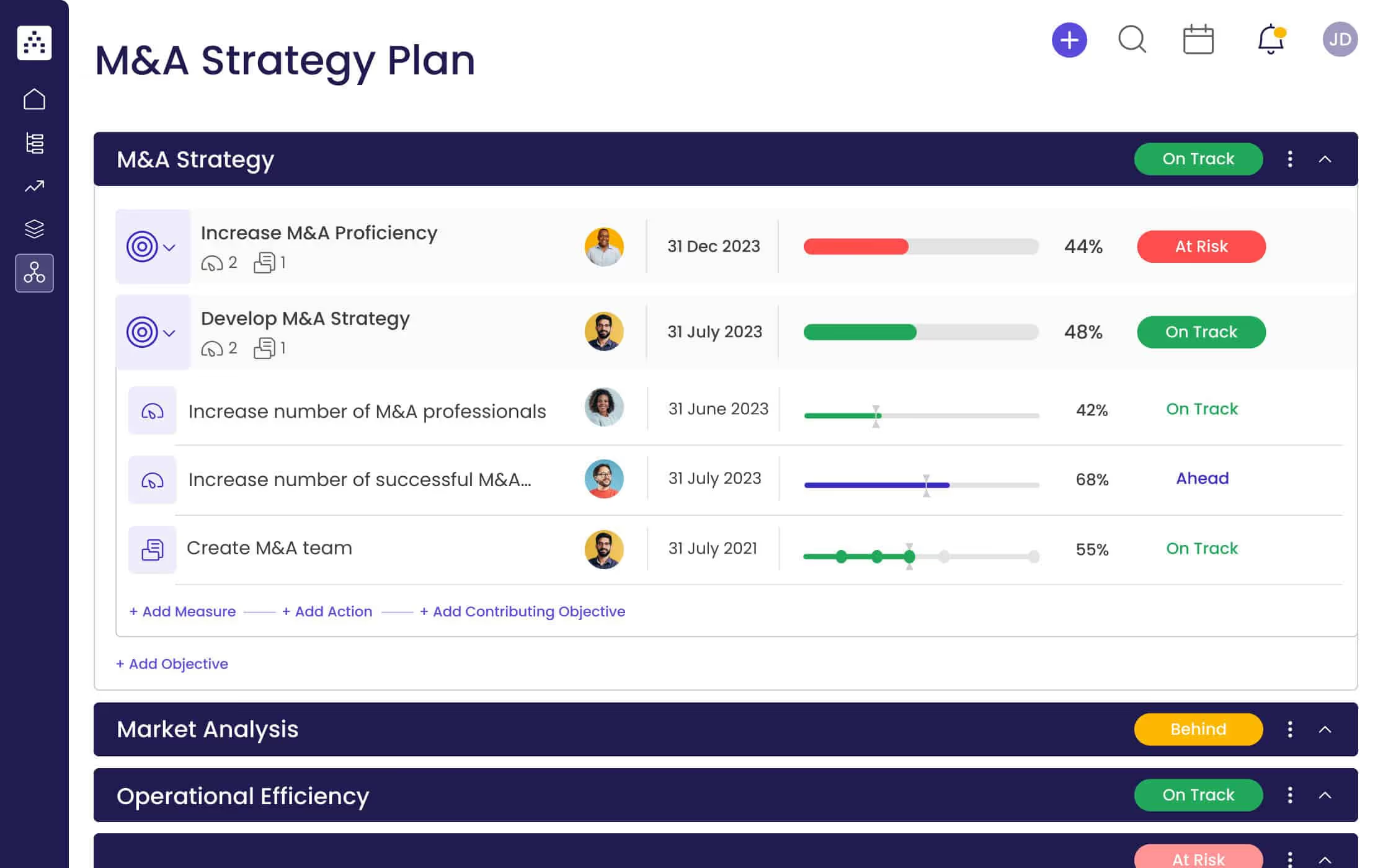Mergers and acquisitions (M&A) are crucial strategies for company growth and market expansion. However, executing a successful M&A process is no easy feat, especially in the dynamic M&A landscape.
“Deals that can bring about strategic business model transformations are more relevant than ever in the current M&A market,” says Malcolm Lloyd, Global Deals Leader of PwC Spain.
This means that simply acquiring a target company is no longer enough. 53% of corporate acquirers fail to outperform their industry peers, while 60% of acquirers regret not having allocated enough resources to culture and change management.
It’s clear that a successful M&A is becoming more of a holistic transformative process, rather than just a “takeover.” For that reason, this article will guide you through the M&A process with an emphasis on integration and transformation. Let’s delve into the ins and outs of an effective M&A process.
What Is A Merger & Acquisition Process?
A merger and acquisition (M&A) process is a strategic business activity that involves the combination of two or more companies to form a single entity, or the acquisition of one company by another.
This process follows a series of well-defined steps, each crucial in ensuring the success of the deal and the seamless integration of the involved entities.
The objective of mergers and acquisitions may be to achieve synergy, gain market share, access new markets, or leverage complementary strengths.
📚Recommended reading: Strategy Study: JPMorgan Chase & Co.'s growth through mergers and acquisitions
Who Should Be Involved In The M&A Process?
The success of an M&A largely depends on involving the right stakeholders and key players throughout all stages. Ideally, these stakeholders should be involved from the buy-side and the sell-side of the mergers & acquisitions.
Essential participants, individuals, and teams include:
- Top management and leadership team: Sets the strategic direction, provides approvals, and makes high-level decisions.
- M&A or corporate development team: Drives the process from start to finish, working closely with other departments.
- Legal and compliance team: Drafts and reviews legal documents, ensuring regulatory compliance.
- Finance and accounting team: Assesses financial viability, conducts due diligence, and evaluates models.
- Human resources team: Evaluates workforce aspects, culture compatibility, and manages employee transition.
- IT and technology team: Assesses IT infrastructure, compatibility, and handles post-acquisition integration.
- Operations team: Evaluates operational aspects and identifies synergies for integration.
- Risk management team: Appraises financial, legal, and operational risks for informed decision-making.
- Communication and public relations team: Manages communications, press releases, and maintains a positive image.
Effective collaboration among these stakeholders is key for a successful M&A process. Open communication, clear roles and responsibilities, and a well-coordinated effort are vital to ensuring the deal fulfills its potential and delivers value to everyone involved.
Now that we’ve seen who needs to be involved during the M&A lifecycle, let’s take a closer look at the key steps throughout the process itself.
6 Key Steps In The M&A Process
.avif)
1. Craft your M&A strategy master plan
The M&A journey begins with formulating a clear merger and acquisition strategy. This is when the acquiring company defines its strategic objectives and lays the foundations for a successful merger or acquisition.
The two main tasks of this step are:
- Business and industry analysis: Thoroughly analyzing your key business performance metrics and the target industry is essential to understanding the market dynamics and what you want to achieve. Identifying opportunities and threats helps to establish a solid foundation for your M&A strategy.
- Defining M&A objectives: Once you understand the bigger picture, you need to define the M&A objectives and reasons for pursuing the deal. Whether it's for market expansion, gaining a competitive edge, diversifying the product/service portfolio, or accessing new technologies, the strategic objectives will guide your entire M&A process. Your M&A objectives must align with your business objectives.
The strategy formulation step is critical for aligning the M&A strategy with the company's strategic objectives. Strategic alignment ensures everyone and everything is working towards the same goals. It makes the M&A process smoother and more efficient.
To clarify this first step and make it easier to execute, we’ve created the Cascade M&A Strategy Template. It will help you to create a clear M&A roadmap, assign responsibilities, and ensure you don’t forget anything important. Click on the link and use it for free.

2. Pinpoint your acquisition targets
After defining the M&A’s objectives and strategy, the acquiring company should conduct thorough research to identify potential target companies that align with its growth plans.
The process involves a systematic approach to assessing and prioritizing candidates based on their compatibility with the acquiring company, as well as with insights from the initial steps.
During this step, the acquiring company must conduct the following evaluations:
- Market research and screening to help identify potential targets within the desired industry or sector.
- Financial evaluation to address the financial health and performance of potential targets.
- Strategic fit analysis to evaluate product offerings, market presence, customer base, intellectual property, and geographic reach.
- Synergy assessment to examine opportunities such as cost savings and cross-selling.
- Risk analysis to assess legal, regulatory, operational, and industry-specific risks.
- Culture fit to evaluate the compatibility between corporate cultures.
After evaluations and assessments have been completed, potential targets are prioritized and ranked. The acquiring company then initiates preliminary discussions to gauge interest, with non-disclosure agreements (NDAs) signed to protect confidential information during this stage.
3. De-risk your investment with due diligence and valuation
After the target selection step, you should be left with one or two target companies.
Now it's time to thoroughly examine and evaluate the top candidate’s financial, legal, operational, and commercial aspects. This step aims to validate the information provided by the target and understand its value and liabilities.
Here are the four main aspects that should be covered in the M&A due diligence phase:
- Financial: Analyze the target's financial statements, financial model, accounting practices, and performance to assess its financial health, profitability, and stability.
- Legal: Examine the target's legal compliance, contracts, licenses, permits, and litigation history to identify any legal risks.
- Operational: Evaluate the target's processes, technology, supply chain, and capabilities to identify any operational challenges.
- Commercial: Assess the target's market position, customer base, competition, and growth prospects to understand its potential for future growth.
Once the due diligence process is complete, determine the fair market value of the target company using various valuation methods, such as discounted cash flow (DCF) and comparable company analysis. Such valuation ensures the deal aligns with your investment criteria.
As a conclusion to this step, the acquiring company may issue a formal Letter of Intent (LOI) or a binding offer to the target company. This should outline the proposed terms of the deal, including the purchase price, deal structure, acquisition process, and any contingencies or conditions.
4. Seal the deal with flawless execution
Everything is set to finalize the acquisition on agreed terms and ensure a smooth transition of ownership and operations.
Here's an overview of what you can expect:
- Negotiation finalization: Both parties finalize negotiation details. This includes addressing concerns and ensuring all legal and financial aspects regarding the M&A transaction are in order.
- Definitive agreement: The acquiring and target companies sign a legally binding purchase agreement.
- Purchase price payment: On the closing date, the acquiring company pays the agreed-upon purchase price in cash, stock, or a combination of both.
- Closing day: The M&A deal is officially completed on the closing day, and the target company becomes part of the acquiring company. Ownership transfer is finalized.
Effective employee communication is essential during this step to address concerns, clarify roles, and foster a positive work environment for the upcoming integration process.
5. Navigate the complexities of integration with ease
Integration follows acquisition. This is when both companies come together to combine their operations, systems, processes, and cultures. It can make or break the M&A.
The primary objective of this step is to ensure a seamless transition and maximize the value created by the acquisition. Here are the main elements of the integration stage:
- Integration planning: Prepare a detailed action plan outlining objectives, timelines, and strategies for effective integration.
- Integration teams: Establish dedicated integration teams to coordinate the process and consider all aspects of the M&A.
- Clear communication: Keep employees informed about progress, changes, and expectations. Address concerns and promote a positive work environment.
- Cultural integration: Align the cultures and values of both organizations to foster engagement and efficiency.
- Resource alignment & process harmonization: Optimize resource allocation, identify redundancies, and streamline processes for increased efficiency.
- IT systems integration: Assess IT infrastructure and develop a plan for system integration and data migration.
- Performance monitoring: Continuously monitor key performance indicators (KPIs) to assess integration success and identify areas that require attention.
- Synergy realization: Work towards realizing the synergies that justified the acquisition in the first place, whether that’s related to cost, revenue, or operations.
6. Stay in control with efficient monitoring and performance reviews
Performance monitoring should begin as soon as you initiate the integration. It’s a continuous process. Once the integration is underway, you should also conduct regular performance reviews.
Monitoring and reviewing key data will help you to evaluate the acquired company's overall success in achieving strategic and financial objectives. You’ll see if you’re on the right path and whether or not you should adapt certain processes and operations.
The performance review usually encompasses:
- Evaluation of strategic objectives: Assess whether the set strategic objectives, such as market expansion or synergies, are being achieved.
- Financial performance analysis: Review key financial metrics, comparing actual results with projections made during the due diligence stage.
- Operational efficiency: Evaluate the impact of integration on processes, systems, and cost reduction.
- Customer and employee satisfaction: Consider feedback and retention rates of both customers and employees.
- Identification of challenges: Address any issues that arise during integration, such as cultural clashes or operational disruptions.
The performance review is an opportunity to learn from the M&A process and identify the best strategies and areas for improvement.
Based on the findings, you may need to make adjustments and course corrections to optimize the integration and performance of the merged company. A performance review is also a great opportunity to document learnings that can help the company in making more informed decisions in future M&As.
📚Recommended reading: Best Practices For Effective Private Equity Portfolio Monitoring
Challenges Of M&A Process And How To Solve Them
Now that we’ve been through the M&A process step by step, let’s take a closer look at the common challenges you want to avoid.
Muddy goals lead to wasted time and resources
One of the major challenges in the M&A process is a lack of clear and well-defined goals. Without measurable objectives, companies struggle to align their strategies and efforts, leading to inefficiencies and missed opportunities.
You can tackle this challenge by defining the desired outcomes and identifying which actions are critical to achieving them. This process helps to develop a roadmap with specific steps that your company needs to take.
Use Cascade's Metrics Library to gather all the key data in one place and analyze your performance. This will make it easier to see which areas need more attention, prioritize what you want to achieve, and define clear goals.

Without the right tools, you’re navigating the M&A process blind
Having real-time visibility into performance is a must during the M&A process, especially during the integration phase. Manual methods of monitoring and reporting (usually involving Excel) are time-consuming and don’t provide timely insights.
Cascade's platform offers automated monitoring through real-time dashboards, making performance tracking and reporting effortless.
.png)
Additionally, Cascade recognizes the importance of risk management and makes it easier to identify, assess, and mitigate risks during the M&A process.
This modern strategy execution platform empowers you with centralized observability and helps you to facilitate a seamless and stress-free M&A process.
📚Recommended read: Strategic Control Simplified: A 6-Step Process And Tools
💡Cascade has an extensive library of free strategy and framework templates, which enable you to easily implement different approaches to strategic control and monitoring.
If you don't involve stakeholders, you risk M&A failure
Failure to engage stakeholders from the outset of the M&A process can lead to suboptimal decisions, resistance, lack of alignment, and challenges in implementing post-merger integration plans.
Cascade emphasizes the importance of engaging internal and external stakeholders right from the start. It makes it easy to track progress, show how the M&A is advancing, and share key insights via the platform’s reporting capabilities. On top of that, you can easily create custom reports tailored to different audiences, including investors, leadership, or board members.

By involving all key stakeholders at the right time, you can also gain valuable insights and minimize the possibility of mistakes. With Cascade Planner, you can easily add an owner (individual or a team) to each plan, objective, project, or action. This provides clear accountability and helps everyone see how their actions contribute to the M&A process, boosting engagement with the M&A strategy and its execution.
Disconnected tools create chaos and hide true performance
Integrating new data into existing workflows is one of the biggest challenges for merging and acquiring companies. Disconnected data makes it difficult to access real-time and accurate information. This results in data silos which escalate into poor collaboration, duplicated work, and wasted time.
Cascade addresses this challenge by providing powerful integrations with data sources and popular tools. This allows teams from different companies to continue using their tools, while Cascade connects data from all portfolio companies in one place.
With Cascade's integrations, companies can aggregate financial, operational, and other performance data in a centralized data hub. This helps you to make data-driven decisions, as well as identify trends, opportunities, and risks before it’s too late.
📚Recommended reading: Centralized Business Observability To Boost Your Bottom Line
Without alignment, M&A success is (almost) impossible
The integration phase of the M&A process demands focused efforts and expertise. However, it’s not just about having a dedicated integration team. It's about making sure that team can see the big picture and how all the pieces fit together to avoid duplicate work and overlapping projects that usually happen when two different companies merge.
That’s where Cascade comes in. It helps the integration team by centralizing coordination and streamlining processes. An M&A process will require the team to juggle many different initiatives and responsibilities. Cascade is ideal for showing all of these projects and roles in one place and assigning who is accountable for what.
Its Relationships feature allows you to map out how all plans, projects, and initiatives are connected and impact each other, which is incredibly useful during complex processes such as an M&A. It allows you to spot dependencies, blockers, and risks that may lie ahead during the different M&A stages so that you and you’re team can be prepared for the unexpected.
%20(1).png)
Ensure The Success Of Your M&A Strategy With Cascade 🚀
Executing a successful M&A strategy requires strategic planning, diligent execution, and the right tools. It’s a demanding project that can become even more challenging with fragmented data and data silos.
That’s why centralized observability is key to minimizing disruptions and setbacks during the M&A. Cascade helps you to achieve this level of visibility and provides the essential tools to streamline your M&A process, from strategy formulation to post-closing integration.
With its customizable dashboards, integrations, automated monitoring, and collaboration features, Cascade empowers you to overcome M&A challenges and help your integration team operate more efficiently.
Ready to take it for a spin? Start today for free or book a guided 1:1 tour with one of our Cascade experts. You’ll see exactly how Cascade can support you and make the whole process smoother.






.png)
.jpg)
.jpg)
%20(1)%20(1)%20(1)%20(1)%20(1).png)



